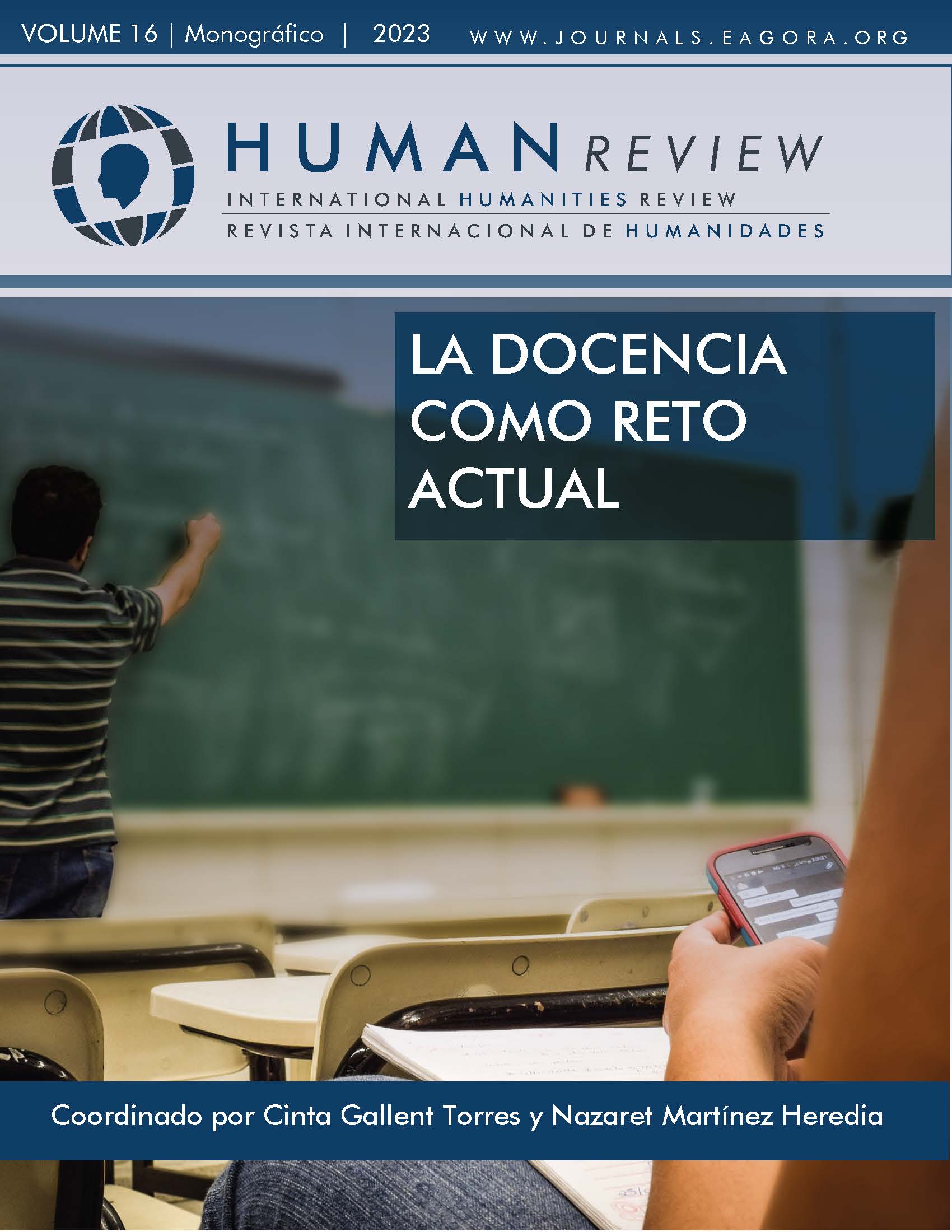Simulation: a new learning tool for medicine students
DOI:
https://doi.org/10.37467/revhuman.v12.4673Keywords:
Teaching, Student, Non-technical skills, Simulation, AeroevacuationAbstract
The main objective of the study is to establish a new teaching strategy in the learning of non-technical skills in medical students through simulation in a real environment. For this purpose, we used a real scenario: the Aeroevacuation Medical Unit (UMAER) located at the Torrejón Air Base (Madrid), where medical students of the Complutense University of Madrid carried out the simulation of air transport of critical patients in a real war environment. The results of the present work show the efficacy of simulation in the learning of non-technical skills in medical students.
References
Aebersold, M. (2016). The History of Simulation and Its Impact on the Future. AACN Adv Crit Care, 27(1), 56-61. doi: 10.4037/aacnacc2016436 DOI: https://doi.org/10.4037/aacnacc2016436
Carretero-Díaz, M. A. y Barrientos-Báez, A. (2019). Necesidad de formar a los cuidadores de personas en situación de dependencia: comunicación y respuesta desde la UCM. Revista de Comunicación y Salud, 9(1), 19-38. http://doi.org/10.35669/revistadecomunicacionysalud.2019.9(1).19-38 DOI: https://doi.org/10.35669/revistadecomunicacionysalud.2019.9(1).19-38
De La Cruz Sánchez, E. E., Poma Henestroza, S. L. y Suárez-Calixto, R. (2022). La educación alimentaria y nutricional en la formación docente. Dos visiones, dos universidades, dos países y un compromiso: Perú-Venezuela. Revista de Comunicación Y Salud, 12, 21-44. https://doi.org/10.35669/rcys.2022.12.e273 DOI: https://doi.org/10.35669/rcys.2022.12.e273
Decker, S., Sportsman, S., Puetz, L., & Billings, L. (2008). The evolution of simulation and its contribution to competency. J Contin Educ Nurs, 39(2), 74-80. http://doi.org/10.3928/00220124-20080201-06 DOI: https://doi.org/10.3928/00220124-20080201-06
Feldman, M., Edwards, CH., Wong, A., Randolph, J., Woleben, CH., Nguyen, A., Grossman, C. (2022). The Role for Simulation in Professional Identity Formation in Medical Students. Simul Healthc, 17(1), e8-e13. http://doi.org/10.1097/SIH.0000000000000583 DOI: https://doi.org/10.1097/SIH.0000000000000583
Ferguson, J., Astbury, J., Willis, S., Silverthorne, J., & Schafheutle, E. (2019) Implementing, embedding and sustaining simulation-based education: What helps, what hinders. Med Educ, 54(10), 915-924. http://doi.org/10.1111/medu.14182 DOI: https://doi.org/10.1111/medu.14182
Galo, Z. (2015). La Unidad Médica de Aeroevacuación Sanid Mil, 71(4), 223 DOI: https://doi.org/10.4321/S1887-85712015000400001
González, C., Cantalejo, F., Couceiro de Miguel, J., Sanchez, G., Seguido, R., Martinez, I., & Chillon, MJ. (2016). Aeroevacuación médica táctica y estratégica de la fuerza desplegada en Afganistán. Sanid Mil, 72(3), 227-232
Goolsby, C., & Deering, S. (2013) . Hybrid simulation during military medical student field training--a novel curriculum. Mil Med, 178(7), 742-745. http://doi.org/10.7205/MILMED-D-12-00541 DOI: https://doi.org/10.7205/MILMED-D-12-00541
Kalaniti, K., & Campbell, DM. (2015). Simulation-based medical education: time for a pedagogical shift. Simulation-based medical education: time for a pedagogical shift. Indian Pediatr, 52(1), 41-45. http://doi.org/10.1007/s13312-015-0565-6 DOI: https://doi.org/10.1007/s13312-015-0565-6
Lake CL. (2005). Simulation in cardiothoracic and vascular anesthesia education: tool or toy?. Semin Cardiothorac Vasc Anesth, 9(4), 265-273. http://doi.org/10.1177/108925320500900401 DOI: https://doi.org/10.1177/108925320500900401
Madsgaard, A., Smith-Strøm, H., Hunskår, I., & Røykenes, K. (2022). A rollercoaster of emotions: An integrative review of emotions and its impact on health professional students‘ learning in simulation-based education. Nurs Open, 9(1), 108-121. http://doi.org/10.1002/nop2.1100 DOI: https://doi.org/10.1002/nop2.1100
McLaughlin, S., Fitch, M.T., Goyal, D.G., Hayden, E., Kauh, C.Y., Laack, T.A., Nowicki, T., Okuda, Y., Palm, K., Pozner, C.N., Vozenilek, J., Wang, E., Gordon, J.A., & SAEM Technology in Medical Education Committee and the Simulation Interest Group. (2008). Simulation in graduate medical education 2008: a review for emergency medicine. Acad Emerg Med, 15(11), 1117-1129. http://doi.org/10.1111/j.1553-2712.2008.00188.x DOI: https://doi.org/10.1111/j.1553-2712.2008.00188.x
Okuda, Y., Bryson, E.O., DeMaria, S. Jr., Jacobson, L., Quinones, J., Shen B., & Levine A.I. (2009). The utility of simulation in medical education: what is the evidence?. Mt Sinai J Med, 76(4), 330-343. http://doi.org/10.1002/msj.20127 DOI: https://doi.org/10.1002/msj.20127
Pajor, M., Xie, N., & Podolej, G. (2022). Medical student education simulation competitions. Clin Teach, e13547. http://doi.org/10.1111/tct.13547 DOI: https://doi.org/10.1111/tct.13547
Peng, P., Su, N., Hou, R., Geng, H., Cai1, F., Zhong, W., Zhang, W., Zhong, J., Yang, Z., & Weiling C. (2022). Evaluation of teaching effect of first-aid comprehensive simulation-based education in clinical medical students. Front Public Health, 10, 909889. http://doi.org/10.3389/fpubh.2022.909889 DOI: https://doi.org/10.3389/fpubh.2022.909889
Ross, B.K., & Metzner, J. (2015). Simulation for Maintenance of Certification. Surg Clin North Am, 95(4), 893-905. http://doi.org/10.1016/j.suc.2015.04.010 DOI: https://doi.org/10.1016/j.suc.2015.04.010
Downloads
Published
How to Cite
Issue
Section
License
Those authors who publish in this journal accept the following terms:
- Authors will keep the moral right of the work and they will transfer the commercial rights.
- After 1 year from publication, the work shall thereafter be open access online on our website, but will retain copyright.
- In the event that the authors wish to assign an Creative Commons (CC) license, they may request it by writing to publishing@eagora.org









